Hudson, Wisconsin
Hudson is a city in St. Croix County, Wisconsin, United States. As of the 2010 United States census, its population was 12,719. It is part of the Minneapolis–St. Paul Metropolitan Statistical Area (MSA). The village of North Hudson is directly to the north of Hudson.
Hudson | |
|---|---|
City | |
| Hudson | |
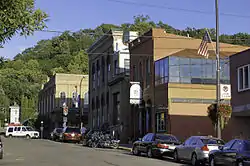 Historic architecture in downtown Hudson, September 2010 | |
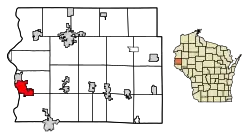 Location of Hudson in St. Croix County, Wisconsin. | |
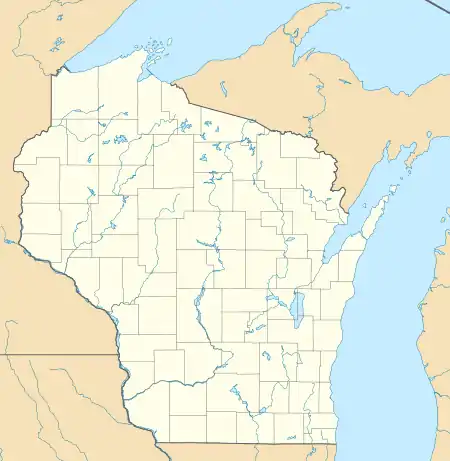 Hudson Location within the state of Wisconsin  Hudson Hudson (the United States) | |
| Coordinates: 44°58′19″N 92°44′42″W | |
| Country | United States |
| State | Wisconsin |
| County | St. Croix |
| Government | |
| • Type | Mayor - Council |
| • Mayor | Rich O’Connor |
| Area | |
| • City | 7.65 sq mi (19.80 km2) |
| • Land | 6.77 sq mi (17.52 km2) |
| • Water | 0.88 sq mi (2.28 km2) |
| Population | |
| • City | 12,719 |
| • Estimate (2019)[3] | 14,103 |
| • Density | 2,084.39/sq mi (804.81/km2) |
| • Metro | 3,269,814 (16th) |
| • Demonym | Hudsonite |
| Time zone | UTC−6 (Central (CST)) |
| • Summer (DST) | UTC−5 (CDT) |
| ZIP codes | 54016, 54017 |
| Area code(s) | 715 & 534 (715 Exchanges: 377,381,386 |
| FIPS code | 55-36250 |
| Website | www.ci.hudson.wi.us |
History
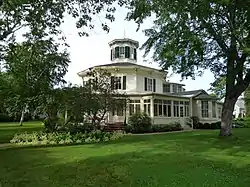
Hudson was settled in the summer of 1840 by Louis Massey and his brother in-law, Peter Bouchea. William Streets arrived at about the same time. Later that same year, Joseph Sauperson (commonly known as Joe LaGrue) took up residence. These four are considered Hudson's original inhabitants. Massey and Bouchea settled at the mouth of the Willow River, near the present-day First and St. Croix Streets. They had been part of the group who lived for some time along the river below Fort Snelling, which appears on some old maps as "Massey's Landing". The 1840s saw a few settlers making their appearance here — Captain John Page, the Nobles brothers, Dr. Philip Aldrich, Ammah Andrews, Moses Perrin, Colonel James Hughes, Daniel Anderson, and others.
Hudson was originally called Willow River. It was later named Buena Vista by Judge Joel Foster, founder of River Falls, after returning from the Mexican War where he fought in the Battle of Buena Vista. In 1852, Alfred D. Gray, Hudson's first mayor, petitioned to change the name of the city to "Hudson", because the bluffs along the St. Croix River reminded him of the Hudson River in his native New York.
A large number of settlers arrived in the 1850s and 1860s, many of whom were ancestors of today's residents. The lumber industry was the prime attraction of the area, and over time sawmills were established throughout the St. Croix Valley.
The Chicago, St. Paul, Minneapolis and Omaha Railway was formed in 1881 from other railroads building between the Twin Cities and Chicago.[4] The shops and headquarters of the Omaha Road were located in Hudson. This route is now part of the Union Pacific Railroad.
On August 30, 1917 a violent mob of 1,000 held a night rally in front of the armory protesting the attempt by the pacifist People's Council of America to hold a conference in Hudson's prizefighting arena. The crowd then moved on the four organizers in the lobby of their hotel and threatened to hang them. Only after the pleadings of county attorney N. O. Varnum were the four allowed to leave town at once and unharmed.[5]
U.S. Highway 12 once crossed the St. Croix River on a toll bridge between Wisconsin and Minnesota, which provided revenue for the town. With the construction of Interstate 94, the toll bridge was removed, though the long causeway extending to the former bridge location is now open to the public as a pedestrian walkway, known as “The Dike.”
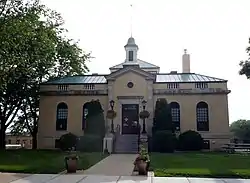
Geography
According to the United States Census Bureau, the city has a total area of 7.41 square miles (19.19 km2), of which 6.53 square miles (16.91 km2) is land and 0.88 square miles (2.28 km2) is water.[6]
Interstate Highway 94, U.S. Route 12 and Wisconsin Highway 35 are three of the main routes in the community.
Climate
| ||||||||||||||||||||||||||||||||||||||||||||||||||||||||||||||||||||||||||||||||||||||||||||||||||||||||||||||||||||||||||||
Demographics
| Historical population | |||
|---|---|---|---|
| Census | Pop. | %± | |
| 1860 | 1,570 | — | |
| 1870 | 1,748 | 11.3% | |
| 1880 | 2,298 | 31.5% | |
| 1890 | 2,885 | 25.5% | |
| 1900 | 3,259 | 13.0% | |
| 1910 | 2,810 | −13.8% | |
| 1920 | 3,014 | 7.3% | |
| 1930 | 2,725 | −9.6% | |
| 1940 | 2,987 | 9.6% | |
| 1950 | 3,435 | 15.0% | |
| 1960 | 4,325 | 25.9% | |
| 1970 | 5,049 | 16.7% | |
| 1980 | 5,434 | 7.6% | |
| 1990 | 6,378 | 17.4% | |
| 2000 | 8,775 | 37.6% | |
| 2010 | 12,719 | 44.9% | |
| 2019 (est.) | 14,103 | [3] | 10.9% |
| U.S. Decennial Census[8] | |||
2010 census
As of the census[2] of 2010, there were 12,719 people, 5,287 households, and 3,324 families living in the city. The population density was 1,947.8 inhabitants per square mile (752.0/km2). There were 5,642 housing units at an average density of 864.0 per square mile (333.6/km2). The racial makeup of the city was 94.8% White, 0.9% African American, 0.3% Native American, 1.4% Asian, 0.7% from other races, and 1.8% from two or more races. Hispanic or Latino of any race were 2.7% of the population.
There were 5,287 households, of which 32.6% had children under the age of 18 living with them, 49.0% were married couples living together, 9.9% had a female householder with no husband present, 4.0% had a male householder with no wife present, and 37.1% were non-families. 29.6% of all households were made up of individuals, and 10.4% had someone living alone who was 65 years of age or older. The average household size was 2.36 and the average family size was 2.95.
The median age in the city was 35.4 years. 25.3% of residents were under the age of 18; 6.7% were between the ages of 18 and 24; 32% were from 25 to 44; 23.4% were from 45 to 64; and 12.3% were 65 years of age or older. The gender makeup of the city was 48.5% male and 51.5% female.
2000 census
As of the census[9] of 2000, there were 8,775 people, 3,687 households, and 2,271 families living in the city. The population density was 1,624.5 people per square mile (627.4/km2). There were 3,831 housing units at an average density of 709.2 per square mile (273.9/km2). The racial makeup of the city was 97.87% White, 0.22% Black or African American, 0.26% Native American, 0.46% Asian, 0.22% from other races, and 0.98% from two or more races. 1.04% of the population were Hispanic or Latino of any race.
There were 3,687 households, out of which 31.3% had children under the age of 18 living with them, 50.4% were married couples living together, 8.1% had a female householder with no husband present, and 38.4% were non-families. 29.1% of all households were made up of individuals, and 9.8% had someone living alone who was 65 years of age or older. The average household size was 2.35 and the average family size was 2.94.
In the city, the population was spread out, with 24.5% under the age of 18, 9.4% from 18 to 24, 34.8% from 25 to 44, 19.9% from 45 to 64, and 11.4% who were 65 years of age or older. The median age was 33 years. For every 100 females, there were 93.5 males. For every 100 females age 18 and over, there were 89.3 males.
The median income for a household in the city was $50,991, and the median income for a family was $63,953. Males had a median income of $42,108 versus $31,268 for females. The per capita income for the city was $26,921. About 1.7% of families and 3.5% of the population were below the poverty line, including 4.0% of those under age 18 and 5.3% of those age 65 or over.
Hudson's median household income in 2017 dollars was $69,035.[10]
Economy
Hudson has grown as a tourist destination and restaurants on the St. Croix in its historic downtown, along with hotels and other businesses that serve traffic on Interstate Highway 94.
The former greyhound racing track, St. Croix Meadows, is being redeveloped to include a hotel, dining, commercial office space, residential condos, a baseball field, an 18-hole mini golf course, and an indoor sports complex with two hockey rinks and a soccer arena.[11]
Arts and culture
Hudson is home of the Phipps Center for the Arts, a regional performing arts center. It is the headquarters of Little Free Libraries and was the site of the first Little Free Library.[12]
Public safety
Hudson is served by the Hudson Police Department, the Hudson Fire Department, and St. Croix EMS & Rescue. These agencies respond to about 400 fire calls, 2000 EMS & rescue calls, and 5000 police calls annually.
Transportation
There are no public use airports in Hudson, though residents have access to the New Richmond Regional Airport, and the St. Paul Downtown Airport for general aviation, and the Minneapolis-Saint Paul International Airport (MSP) for commercial, and international flights. There is an airport shuttle from Hudson to MSP.
Education
Hudson is served by the Hudson School District. Public schools located in the city include E. P. Rock Elementary School, Hudson Prairie Elementary School, North Hudson Elementary School, Willow River Elementary School, Houlton Elementary School, River Crest Elementary School, Hudson Middle School, and Hudson Senior High School.
St. Patrick, a Catholic parochial school, is also located in Hudson.
In 2010 the University of Wisconsin-River Falls opened a satellite campus in Hudson with a focus on undergraduate and graduate degrees for adult students.
Notable people
- Benjamin Allen, Wisconsin State Senate
- Lynn H. Ashley, Wisconsin State Assembly
- Julius Beer, Wisconsin State Assembly
- Jim Bertelsen, National Football League player
- Todd Bol, Little Free Library founder
- Philo Boyden, Wisconsin State Assembly
- George W. Chinnock, Wisconsin State Assembly
- John A. Chinnock, Wisconsin State Assembly
- Harvey Clapp, Wisconsin State Assembly
- Moses E. Clapp, U.S. Senator from Minnesota
- Otis Clymer, Major League Baseball player
- Richard H. Cosgriff, Medal of Honor recipient
- Thomas Cleland Dawson, United States diplomat
- Davis Drewiske, professional hockey player, Montreal Canadiens
- James A. Frear, U.S. Representative
- David C. Fulton, Wisconsin State Assembly
- Marcus Fulton, Wisconsin State Senate
- Phil Gallivan, baseball player
- Jay R. Hinckley, Wisconsin State Assembly
- John Huot, Minnesota House of Representatives
- James B. Hughes, politician, abolitionist, lawyer
- Donald L. Iverson, Wisconsin State Assembly
- Andrew P. Kealy, Wisconsin State Assembly
- Arthur D. Kelly, Wisconsin State Assembly
- Max Malanaphy, Drag Queen who grew up in Hudson
- Pamela Matson, Stanford scientist who grew up in Hudson[13]
- Frank Nye, U.S. Representative from Minnesota
- Ted Odenwald, baseball player
- Wilder Penfield, neurosurgeon pioneer
- William Henry Phipps, Wisconsin State Senate
- Thomas Porter, Wisconsin State Assembly
- Bobby Reis, baseball player
- Kitty Rhoades, Wisconsin State Assembly
- Barry Rose, Professional football player
- Bjørn Selander, racing cyclist
- John Coit Spooner, United States Senator
- Philip Loring Spooner, tenor
- Horace Adolphus Taylor, Wisconsin State Senate
- Kraig Urbik, professional football player
References
- "2019 U.S. Gazetteer Files". United States Census Bureau. Retrieved August 7, 2020.
- "U.S. Census website". United States Census Bureau. Retrieved 2012-11-18.
- "Population and Housing Unit Estimates". United States Census Bureau. May 24, 2020. Retrieved May 27, 2020.
- Robert Joseph Casey (1948). Pioneer railroad the story of the Chicago and North Western System. Robert Joseph Casey. pp. 151–. GGKEY:WK1RLEKNSCN.
- Eau Claire Leader, August 31, 1917
- "US Gazetteer files 2010". United States Census Bureau. Archived from the original on 2012-01-24. Retrieved 2012-11-18.
- "NASA Earth Observations Data Set Index". NASA. Retrieved 30 January 2016.
- "Census of Population and Housing". Census.gov. Retrieved June 4, 2015.
- "U.S. Census website". United States Census Bureau. Retrieved 2008-01-31.
- "U.S. Census Bureau QuickFacts: Hudson city, Wisconsin". www.census.gov. Retrieved Aug 9, 2020.
- Apr 13th 2018 - 10am, Rebecca C. Mariscal. "Dog track sale finalized, new development coming". RiverTowns. Retrieved Aug 9, 2020.
- "About Little Free Library". littlefreelibrary.org. January 9, 2017. Retrieved October 8, 2017.
- "Pamela Matson ESA President 2001-2002" (PDF). Archived from the original (PDF) on 2014-06-29. Retrieved 2013-11-28.
External links
 Hudson, Wisconsin travel guide from Wikivoyage
Hudson, Wisconsin travel guide from Wikivoyage Media related to Hudson, Wisconsin at Wikimedia Commons
Media related to Hudson, Wisconsin at Wikimedia Commons- Official website
- Hudson Chamber of Commerce and Tourism Bureau
- Around the Corner with John McGivern -- Hudson Video produced by Milwaukee PBS
